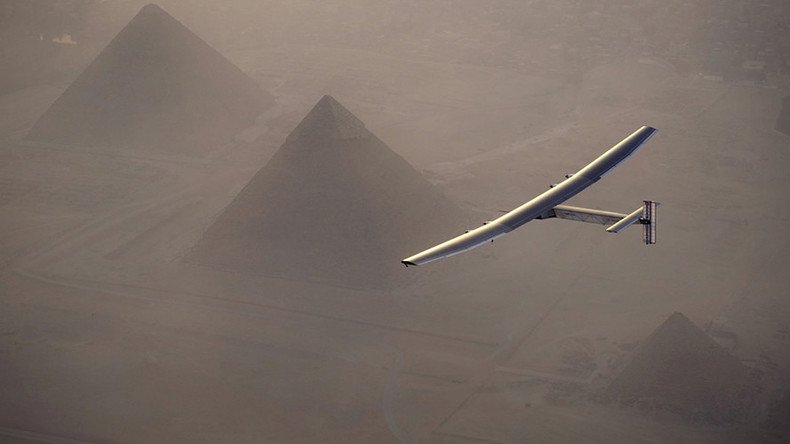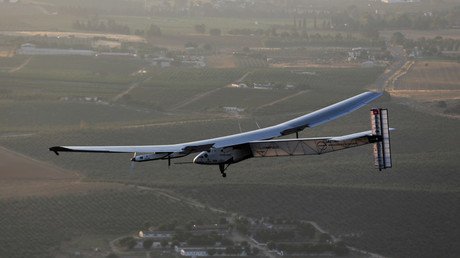Solar Impulse 2 takes off on last leg of round-the-world journey

An airplane which solely relies on solar energy has taken off on the last leg of its round-the-world-trip. It is expected to reach its final destination in some 48 hours, which would make it the first solar-powered aircraft to circle the globe.
On Sunday at 1:30am local time, the one-of-a-kind plane took off from Cairo and is now heading towards Abu Dhabi - the city from which it started its long journey last year. It is expected to reach the city within the next 48 hours.
Last week, the aircraft made a landing in Egypt after a flight from Seville, Spain. The pilots were forced to postpone the following takeoff from Cairo to the UAE due to extreme heat in Saudi Arabia.
On the Solar Impulse blog, the Mission Control Center team said they “identified a weather window that could allow us to overcome the challenging high temperatures across Saudi Arabia and hopefully land in Abu Dhabi after 48 hours.”
“We want to share with you the suspense of an attempted takeoff for this last leg of the round-the-world adventure. If we manage to get Si2 airborne, this will be Solar Impulse’s last flight, so come with us!”
Bertrand Piccard and Andre Borschberg, Swiss pilots and founders of the of the Solar Impulse project, took turns flying the plane since March of last year when it began the world tour began. They have been working on the project seeking to promote clean energy technology for over 10 years. Piccard is behind the yoke for the last flight.
“The round the world flight ends in Abu Dhabi, but not the project,” Piccard told Reuters a few days before the takeoff from Cairo. “The project is a big promotion of clean technologies around the world and the legacy of Solar Impulse is the created international community,” he said.
Sounding hopeful Piccard said that the project means that “There will be passengers very soon in electric airplanes that we will charge on the ground.”
Although excited with the last flight, Picard admitted that the final piece of the journey would not be a piece-of-cake.
BREAKING @bertrandpiccard has taken off from #Cairo for the last flight of the journey to #AbuDhabi#futureiscleanpic.twitter.com/2ufDjAS5VK
— SOLAR IMPULSE (@solarimpulse) 23 июля 2016 г.
“It's a very, very hot region... it’s going to be an exhausting flight,” he said, AFP reported.
“Technically it's close to the limits that we have set in terms of temperature, so that's something which we did not experience before,” he said via Skype from mission control in Monaco.
“But with the temperature profile that we see over the coming days, we should be all fine.”
Last week, the aircraft made a landing in Egypt after a flight from Seville, Spain. The following takeoff from Cairo was, however, postponed due to extreme heat in Saudi Arabia and Piccard’s falling sick.
Just took off from #Cairo to achieve the 1st round-the-world solar flight. A dream I have since 1999 #futureiscleanpic.twitter.com/6jyjqarfe2
— Bertrand PICCARD (@bertrandpiccard) 24 июля 2016 г.
The plane has four engines which rely entirely on the solar energy which gets collected during the day. As many as 17,000 solar cells to collect the energy are fitted on the aircraft’s wings, which are wider than those of a Boeing 747. The energy is also stored in the plane’s batteries so it would be able to fly during the night.
The plane is capable of reaching an altitude of 8,500 meters (28,000 feet) and speeds of 80kph (50mph).
The fuel-free airplane began its journey on March 9, 2015, from Abu Dhabi. The flight from Cairo to Abu Dhabi is the last one of the round-the-world journey consisting of 17 flights.
On Saturday the plane became the first solar aircraft to cross the Atlantic Ocean as it flew 70 hours from New York to Seville.













